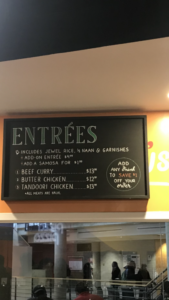When I first heard that the university was introducing a new Indian restaurant on campus, Masala: Flavours of India, I was immediately thrilled by the prospect of having food I actually wanted to eat right in the heart of SLC (see: SLC Tims rat incident). But I was also nervous: too often have I encountered South Asian food at restaurants that lack the depth that makes the cuisine I grew up with feel so hearty and nourishing. For two days, I ate at Masala to see whether it truly honoured the flavours of India, as it so boldly proclaims. While I’m not sure if it achieves quite that, and its quality may vary, it’s still well worth a try because the dishes that succeed are pretty damn good as far as campus food goes.

As a vegetarian (a picky one too), I usually worry about having to settle for an overpriced, sad-looking salad while eating out. Luckily that wasn’t the case with Masala, which had a set list of vegetarian entrees that I, for the most part, enjoyed sampling. This came as little surprise. Vegetables are the bread and butter (or naan and ghee) of what makes South Asian food tick, and what I love as a vegetarian is that many of the dishes I grew up loving – dals, curries, pakoras, and paneers – are already vegetarian-friendly. On my first day, I ordered the chana fries and vegetable biryani, which, together, came out to $16.95. That’s more than I’m typically willing to spend on a meal but anyone familiar with SLC food prices (or on-campus food prices in general) probably wouldn’t find themselves too outraged by this roughly-nine-bucks-a-meal ratio.
Let’s start with the bad news first: the chana masala fries (for those unfamiliar, they’re just regular French fries slathered in chickpea curry). They were decent but not delicious since they lacked any real zhuzh or depth. Fusion food should involve a thoughtful pairing of complementary flavours and textures — it shouldn’t just be the love child of two distinct dishes that were haphazardly mingled for no real reason other than crude experimentation. The biryani was a bit better. The paneer the rice came with earned my stamp of approval, but there wasn’t nearly enough of it. In fact, I didn’t even realize that there was paneer at all until my fourth or fifth bite when I found the little cubes tucked in the corner of my food. The workers also kindly added crispy onions to make the rice more exciting, which provided some delicious, salty crunch and texture to the meal, but ultimately clashed with the other elements of the dish. (For a better combo: I’d recommend adding a little pickle, or achar, which never hurts any dish as far as I’m concerned). I also chose to add a tomato and red onion salad to my rice, and that, coupled with the raita, provided the perfect cooling contrast to the rest of the dish, particularly for those less acquainted with spice.
I have little to say on the toasted naan that came with the biryani. Was it good? I guess. But I have naan sitting in my freezer from Noor’s Food Market that I plan to eat for a fraction of the price tonight, so do with that information what you will.
Now, moving onto the saag paneer, which is hands-down the standout here. There’s a reason that it was recommended to me by the worker there, and I’ve also had it approved by my meat-eating friends. With a sauce this flavourful and rich, you’d be hard-pressed for another meal on campus so comforting and indulgent. The paneer acts as the perfect sponge for soaking up the green chili, coriander, and yogurt, along with the other flavours it’s infused with – if you’re not careful, you might nearly forget that you’re eating in a campus food court.
For those more curious about the meat options, fear not – on my second day of eating at Masala, I consulted two friends to gauge the quality of the meat options. They each tried a different dish. My friend Brandon Phan, who doesn’t eat much Indian food, joined me after our Victorian Lit class to try the tandoori chicken. He was happy overall with how well the meat held up since he initially worried that it’d be too dry. “The [tandoori] chicken is juicier than I thought it would be, which is a good thing,” he said. He was less thrilled with the samosas, which we both agreed were too dry (“more dry than they usually are,” as Brandon put it). Luckily, other better options exist for samosa enthusiasts to fawn over, and the Chaat Samosa dish serves its samosas inside a chickpea curry that keeps them from getting too crackly and dry.
My other friend Abhiraj Lamba, who is Indian and my frequent co-conspirator in impulsive UberEats orders of South Asian food (namely momos), was less impressed with the beef curry he tried. “I wouldn’t stand in a queue for it,” he said, though he acknowledged that the restaurant was a good option for when he’s “in a rush and want[s] to grab something to eat on campus.”
The reviews and results are admittedly a bit mixed, and not every dish at Masala lands. But for the ones that do, there’s definitely more than enough heat and heart to fill up your plate, your stomach, and your desire for some real food. It’s about time we had some.































